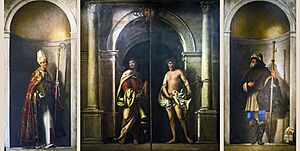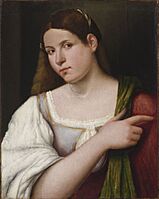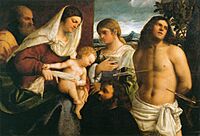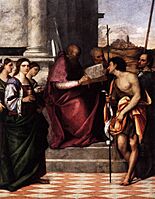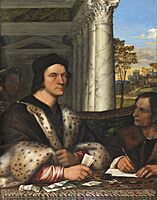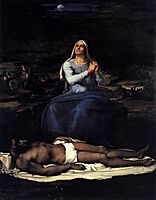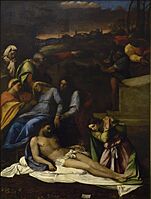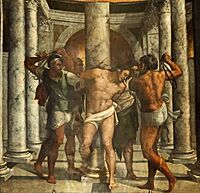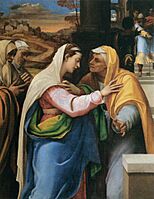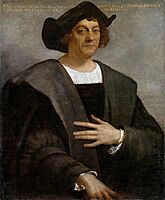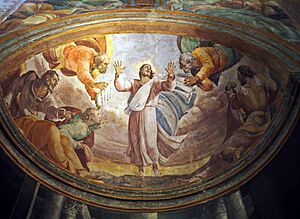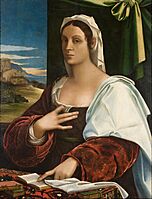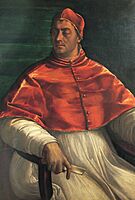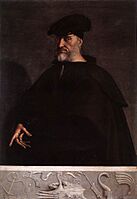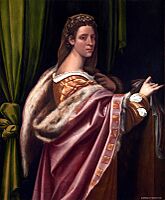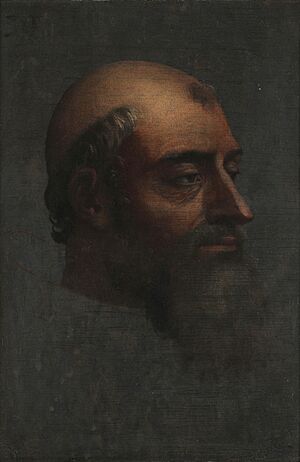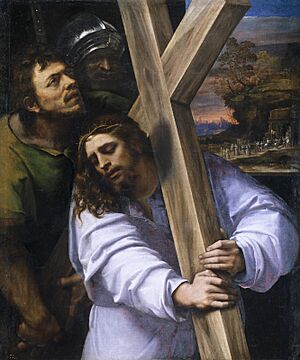Sebastiano del Piombo facts for kids
Quick facts for kids
Sebastiano del Piombo
|
|
|---|---|
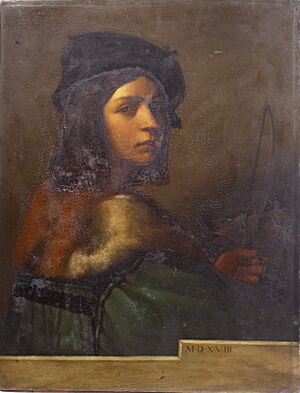
Copy of The Violinist, sometimes claimed to be a self portrait
|
|
| Born |
Sebastiano Luciani
c. 1485 Probably Venice, Italy
|
| Died | 21 June 1547 (aged 61–62) Rome, Papal States
|
| Education | Giovanni Bellini, probably Giorgione |
| Known for | Painting |
| Movement | High Renaissance |
Sebastiano del Piombo (born around 1485 – died June 21, 1547) was a famous Italian painter. He lived during the High Renaissance and early Mannerist periods. He was special because he combined the rich colors of the Venetian art style (where he learned) with the grand shapes of the Roman style.
He was born Sebastiano Luciani in Venice. After moving to Rome in 1511, people called him Sebastiano Veneziano or Viniziano, meaning "Sebastian the Venetian." Later, in 1531, he got a new job working for the Pope. He became the "Keeper of the Seal to the Papacy." This job involved sealing important documents with lead. So, he earned the nickname del Piombo, which means "of the Lead". His friends, like the famous artist Michelangelo, even called him Fra Bastiano ("Brother Bastian").
Sebastiano was not always a fast or busy painter. His painting slowed down even more after he became the piombatore. This job meant he had to be with the Pope almost every day. He also had to travel with the Pope and become a friar, even though he had a wife and two children. After this, he mostly painted portraits. Not many of his artworks from this time still exist compared to other great artists of his era.
When he was young in Venice, he was a successful musician who played the lute. Then he started painting. He learned from famous artists like Giovanni Bellini and Giorgione. When he first arrived in Rome, he worked with Raphael. He also became good friends with Michelangelo. Michelangelo even tried to help Sebastiano get more painting jobs. He wanted Sebastiano to compete with Raphael. Sebastiano painted portraits and religious scenes using oil paints. He avoided big fresco paintings, which took up a lot of Raphael's and Michelangelo's time.
In his early career, other great painters in Venice and Rome sometimes overshadowed him. But after Raphael died in 1520, Sebastiano became Rome's top painter. He didn't have many students, so his influence on other artists was limited.
Contents
Life in Venice: Early Years as an Artist
Sebastiano del Piombo was likely born in Venice, Italy. We don't know much about his family. He was probably born around 1485. This is based on a statement that he was 62 when he died in 1547. He was first known as a musician and singer. This might mean he came from a well-off family. It's not clear if he was a professional musician.
He started training as a painter a bit later in life, probably when he was 18 or 20. This was around 1503–1505. He became a student of Giovanni Bellini. He probably also learned from Giorgione. You can see their influence in his early paintings. Like his friend Raphael, Sebastiano was good at getting along with other artists and people who paid for art.
No artworks from his time in Venice are clearly signed or documented. Many paintings thought to be his are still debated by art experts. Some of his works were even confused with Giorgione's. He might have finished paintings that Giorgione left unfinished when he died in 1510.
One of his earliest known works is a portrait of a girl in Budapest, painted around 1505.
He is also known for the Judgement of Solomon painting. It is now at Kingston Lacy. This large, dramatic painting was also thought to be by Giorgione for a long time. It might have been left unfinished around 1508. After being cleaned in the 1980s, you can see traces of three different versions of the painting. It is still over 2 meters by 3 meters. It seems it was even bigger originally. The painting shows a detailed background with buildings. The figure of the executioner, without clothes, looks like a classical sculpture.
Around 1508–1509, he painted four tall figures of saints for the organ-shutters of San Bartolomeo, Venice. These are now in the Gallerie dell'Accademia in Venice. They look very much like Giorgione's style. They were painted around the same time Giorgione was painting frescos nearby. Sebastiano's technique improved, using thicker brushstrokes. The figure of Saint Sebastian shows he was studying classical sculptures.
His main altarpiece for San Giovanni Crisostomo, Venice, painted in 1510–1511, is very important. It shows Saint John Chrysostom reading. Mary Magdalene looks out at the viewer, along with other saints. This painting shows a new style with fuller shapes and broader movement. This might have been influenced by the Florentine painter Fra Bartolommeo. He was in Venice in 1508. Parts of Sebastiano's painting were new and later copied by other Venetian painters, even Titian.
-
Portrait of a Girl in Budapest, c. 1505. This is one of his earliest paintings.
-
Sacra conversatione, c. 1507, Louvre
Life in Rome: New Artistic Challenges
Moving to Rome and New Style (1511–1520)

In 1511, Agostino Chigi, a rich banker for the Pope, brought Sebastiano to Rome. Sebastiano stayed in Rome for the rest of his life. He started by painting mythological scenes in Chigi's Villa Farnesina. He quickly adapted to the Roman style, especially Michelangelo's. Michelangelo's Sistine Chapel ceiling had just been finished. Sebastiano then painted a large Polyphemus.
Soon after arriving, Sebastiano also started painting on easels. These paintings showed his new style. His Death of Adonis (around 1512–1513) shows he was combining Roman and Venetian styles. He made his figures larger and more powerful.
Around 1515, Sebastiano became friends with Michelangelo. Michelangelo wanted Sebastiano to be his "deputy" in painting. Michelangelo was busy with his sculpture projects. He wanted Sebastiano to compete with Raphael, as their rivalry was strong. Michelangelo even gave Sebastiano ideas and designs.
Their first joint project was Sebastiano's important Pietà in Viterbo. This painting shows Christ lying at the bottom, with the Virgin Mary looking up to Heaven. The figures do not touch. This was Michelangelo's idea. The back of the painting panels has large charcoal sketches, likely by both artists. In 1516, Sebastiano painted a similar scene, the Lamentation of Jesus (now in the Hermitage Museum). This one used his own design.
These works led to a commission for Sebastiano to decorate a chapel in San Pietro in Montorio in Rome. Michelangelo made a drawing for the Flagellation of Jesus in the chapel. Sebastiano finished the chapel in early 1524. The Flagellation is painted in oil on plaster. This was a new method, and Sebastiano was very good at it.
His last major work from this period was The Raising of Lazarus. It is now in the National Gallery, London. Cardinal Giulio de Medici ordered this painting in 1516. It was meant to compete with Raphael's Transfiguration. Both paintings were to hang in Narbonne Cathedral in France. Michelangelo provided drawings for Lazarus and the two men helping him. When the two paintings were shown together in the Vatican after Raphael's death in 1520, both were praised. However, Raphael's painting was generally preferred.
In the early 1520s, Sebastiano finished the Borgherini Chapel. He painted a Transfiguration above his Flagellation. These paintings showed ideas from a text called Apocalipsis Nova. This text predicted a new age of peace. The Flagellation showed the problems of Christianity at the time. The Transfiguration showed a glorious future.
-
The Hermitage Museum Lamentation of Jesus, 1516. This is the center part of the triptych.
-
The Flagellation in San Pietro in Montorio, based on a drawing by Michelangelo, 1516 or later.
-
The Louvre Visitation, 1518–19
-
Portrait of a Man, Said to be Christopher Columbus, 1519
Leading Roman Painter (1520–1531)

When Raphael died in 1520, Sebastiano became the most important painter in Rome. He tried to get Raphael's next big project in the Vatican. But Raphael's workshop, with his drawings, got the job instead. Michelangelo also couldn't help Sebastiano much because he was busy with his own sculpture projects. In the years that followed, Sebastiano mostly avoided very large church commissions. He focused on portraits, where he was very well-known. He also painted religious scenes on easels. Examples include his Visitation for France (1518–19, now in the Louvre) and his Madonna of the Veil (around 1525). He brought his grand, classical style to these works.
Events outside of art greatly affected his career during this time. In 1522, there was a plague in Rome. He might have left Rome for a long time. There is little information about his work for over a year. In 1523, Giulio de Medici became Pope Clement VII. Sebastiano then became part of the Vatican court. He painted several portraits of the Pope and other works for him. In 1527, he stayed with the Pope during the terrible Sack of Rome. He also went with the Pope to Orvieto. He seems to have spent time in Venice in 1528 and maybe 1529. This was his first known return to Venice since 1511. The Sack of Rome ended the High Renaissance in Rome. It scattered Raphael's workshop and other artists. It also greatly reduced the confidence of art patrons.
In 1531, Sebastiano asked Pope Clement for the profitable job of "piombatore." He got the job after promising to pay a yearly sum to the other main candidate. To hold this position, he had to become a friar. This was despite having a wife and two children. After this, his paintings often had signatures like "F(rater) Sebastianus Ven(etus)", meaning "Brother Sebastian the Venetian."
Later Years and Final Works (1532–1547)
Sebastiano painted less after taking his court job. However, he might not have painted as little as some stories suggest. Large projects could take many years to finish, like a Pieta for Spain. This was the last painting where Michelangelo helped him with a drawing. Some people say Sebastiano turned away from art for an easy life as a well-paid courtier. But this might not be entirely true.
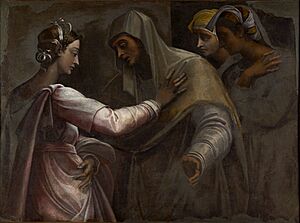
His friendship with Michelangelo ended in 1534. They disagreed about Michelangelo's Last Judgment in the Sistine Chapel. Sebastiano wanted the Pope to insist that Michelangelo paint it in oil on plaster. This was a technique Sebastiano had developed. Michelangelo eventually refused and insisted on painting in fresco. He famously said that oil painting was "an art for women and for leisurely and idle people like Fra Sebastiano."
Sebastiano never finished two church projects. A large altarpiece of the Birth of the Virgin in Santa Maria del Popolo, Rome, was started in the late 1530s. It had to be finished by another artist after Sebastiano's death. He also started a large Visitation for Santa Maria della Pace, Rome. It was still half-finished when he died in 1547. Parts of it are now at Alnwick Castle. These show a simple, impressive style.
Sebastiano died after a short illness on June 14, 1547, at age 62. He wanted to be buried simply in Santa Maria del Popolo. He asked that the money saved from a simple burial be given to the poor. His remains were later moved in 1561.
-
Said to be Vittoria Colonna, by 1525. This painting already shows a very simple style.
-
Pope Clement VII, about 1526
Painting Techniques
Sebastiano learned the Venetian way of painting. This involved using rich, changing colors in oil paints. In The Raising of Lazarus (1517–1519), he used many different colors. The painting shows off his Venetian skill. As he got older, he became less interested in bright colors. Many of his later works are darker, with only small touches of bright color.
His early works often used a Venetian technique. He would draw freehand on the surface before painting. But after some years in Rome, he started using full-size drawings called cartoons for his frescos. He would prick holes along the lines of the cartoon. Then he would "pounce" soot through the holes. This made dotted lines on the wall for him to follow. This method was common in Florence and Rome. However, his Transfiguration in the Borgherini Chapel was his last fresco.
From early on, he liked to try new things in his compositions and techniques. He was especially interested in painting with oils on new surfaces. These included plaster, stone, alabaster, or slate. Many of his paintings on these unusual surfaces have lasted well, even though they tend to be dark. Sometimes, he left the background unpainted. For example, a small portrait of Clement VII in Naples is painted on slate.
He made excellent drawings, mostly for planning his paintings. He liked to draw on light blue paper with black chalk and white highlights. This was a Venetian custom. Few of his early drawings still exist. He might have changed his drawing methods to be more precise after being influenced by Michelangelo and Raphael.
Students and Assistants
Sebastiano seemed to paint mostly by himself. He had "no more than merely mechanical assistance" from his studio. This means he didn't have many important students who learned his style. We don't know if this was because he avoided large paintings or because of his court job.
His Life and Friendship with Michelangelo
We learn about Sebastiano's personality from stories by Vasari and from letters he wrote to Michelangelo. Vasari knew Sebastiano, but probably not very well. Vasari's book, Lives, came out after Sebastiano died. Vasari knew Michelangelo better. His description of Sebastiano might be influenced by Michelangelo's feelings after their disagreement in 1534. Vasari often complained that Sebastiano was lazy and cared more about a comfortable life than his art, especially after 1531.
Vasari said that later in life, Sebastiano lived in a nice house. He had good food and often entertained friends and visitors. He was always cheerful, funny, and good company. He became red-faced and a bit fat, as shown in his portrait in Vasari's book.
As mentioned, he became close to Michelangelo around 1515. Even though they eventually argued, few people stayed friends with Michelangelo for nearly twenty years. In 1519, Michelangelo became the godfather to Sebastiano's first son, Luciano. After that, Sebastiano called Michelangelo "My dearest compare" (godfather) in his letters. Their friendship had a small problem in 1520. Sebastiano asked Michelangelo to write a letter to a cardinal, recommending Sebastiano for Vatican projects. Michelangelo sent a joking letter. Sebastiano showed it to the cardinal without reading it. Sebastiano complained that it became "practically the only topic of conversation at the Palace, and it makes everyone laugh." It also didn't help him get Vatican jobs.
In 1521, Sebastiano helped Michelangelo with the Risen Christ statue in Rome. In 1531, Sebastiano wrote a sad letter. He said, "I still don't feel I am the same Bastiano that I was before the Sack; I still don't feel in my right mind." Their friendship never recovered after the argument over the Last Judgement in 1534.
Selected Artworks
- Venetian period
- Judgement of Solomon, Kingston Lacy, c. 1505–1510, unfinished
- Altarpiece in San Giovanni Grisostomo, Venice (c. 1509)
- Organ-shutters of San Bartolomeo, Venice, now Gallerie dell'Accademia, Venice
- Portrait of a Young Woman as a Wise Virgin (1510) National Gallery of Art, Washington
- Salome or Judith, 1510, National Gallery, London
- Roman period
- Polyphemus (1511) – fresco, Villa Farnesina, Rome
- The Metamorphosis (1511) – fresco, Villa Farnesina, Rome
- Christ Carrying the Cross, c. 1513–14, Prado
- Martyrdom of St. Agatha – Palazzo Pitti, Florence
- Portrait of a Man (c. 1515) – Oil on poplar, 115 x 94 cm, Museum of Fine Arts, Budapest
- Portrait of a Girl (c. 1515) – Oil on wood, 52,5 x 42,8 cm, Museum of Fine Arts, Budapest
- Portrait of a Warrior (c. 1515)
- Cardinal Bandinello Sauli, His Secretary, and Two Geographers (1516) National Gallery of Art, Washington
- Christ descending into Limbo – Prado Museum, Madrid, 1516
- Transfiguration, Flagellation, saints and prophets San Pietro in Montorio, Rome , 1516–1524
- A Prophet Addressed by an Angel (1516–17) National Gallery of Art, Washington
- Pietà (c. 1517) – Panel painting, Museo Civico, Viterbo, Italy
- The Raising of Lazarus (1519) National Gallery, London
- Hoy Family (c. 1520) Burgos Cathedral
- Portrait of a Humanist (1520) National Gallery, Washington D.C.
- Portrait of Andrea Doria (1526) Galleria Doria Pamphilj, Rome
- Portrait of Pope Clement VII (half-length, about 1526) Museo di Capodimonte, Naples
- Portrait of Clement VII (with beard, c. 1531) – Oil on Slate 105.4 x 87.6 cm Getty Museum, Los Angeles
- Portrait head of Clement VII on slate, c. 1531, Museo di Capodimonte, Naples
- Birth of the Virgin – Oil on peperino, Santa Maria del Popolo, Rome, never finished
- Christ Carrying the Cross (1535–1540) – Oil on slate, 157 x 118 cm, Museum of Fine Arts, Budapest
- A Lady as Saint Agatha, after 1530, as signed with "F." for "Frate". Probably 1540s, National Gallery, London
- Visitation, originally Santa Maria della Pace, Rome, unfinished with 3 fragments now Alnwick Castle, 1540s
See also
 In Spanish: Sebastiano del Piombo para niños
In Spanish: Sebastiano del Piombo para niños


